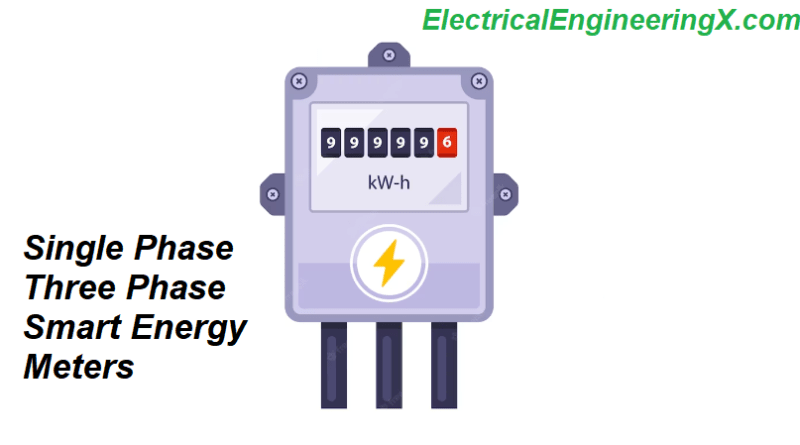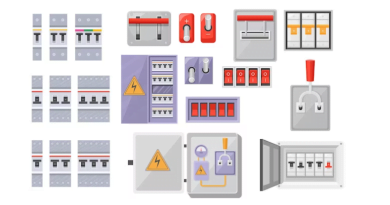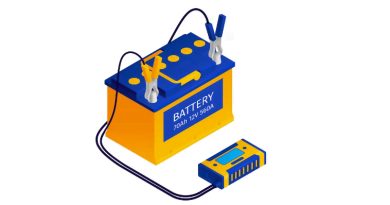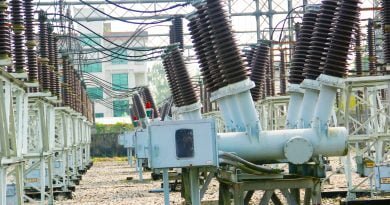Single Phase and Three Phase Smart Meters or Smart Energy Meters
Single Phase and Three Phase Smart Energy Meters or Smart Power Meters
Smart meters represent the next generation of energy metering technology. Unlike traditional electromechanical meters, smart meters can use two-way communication networks to measure and transmit granular power usage data in real-time. Both single-phase and three-phase intelligent meters offer capabilities to enable smart grid functionality and energy management applications.
Despite being slow, the existing billing system is also prone to errors in the manual meter reading process; Smart Energy Meters provide an effective and less costly solution over traditional energy meters. They also make utility companies and their consumers equally aware and updated on real-time energy consumption, which helps in utilizing energy consumption in a better and more economical way. The Project is to implement Smart Metering using the GSM technique for measuring energy consumption in discrete intervals. Collecting data and sending it back to utility service providers and consumers is done through the existing GSM network of cellular companies. The utility company server centrally controls, manages and processes this information. Apart from the cost savings about remote readings of meters, smart energy meters will introduce transparency in the meter reading and eliminate non-payment of electricity bills.
Introduction to Smart Meters
Smart meters are digital devices that measure and record real-time electricity, gas, or water consumption and relay the information to utility companies. They are designed to replace traditional electromechanical meters that require manual reading. Smart meters can measure and transmit granular power usage data in real time using two-way communication networks. This allows for accurate billing, quick response by the utility to usage spikes, and automated outage notifications.
Single Phase Smart Meters
Single-phase smart meters are designed for residential and small commercial sites running on 120V/240V single-phase power.
Architecture
The architecture of a single-phase smart meter includes a metrology chip for measurement, a communication module, display, memory, power supply, and security mechanisms.
Measurement Method
Single-phase meters use integrated or shunt-connected current transformers to measure current and voltage parameters.
Communication Technologies
Common communication protocols include Power Line Communications, Radio Frequency mesh networks, Wi-Fi, and Cellular.
Advantages
Single-phase smart meters offer remote reading, tamper detection, power quality monitoring, and net metering capabilities at affordable costs.
Three-Phase Smart Meters
Three-phase smart meters serve large residential, commercial, and industrial sites running on 240V/415V three-phase power.
Architecture
The architecture of a three-phase smart meter is similar to that of a single-phase smart meter. It includes a metrology chip for measurement, a communication module, a display, memory, power supply, and security mechanisms.
Measurement Method
Three-phase meters use current transformers to measure current and voltage parameters.
Communication Technologies
Common communication protocols include Power Line Communications, Radio Frequency mesh networks, Wi-Fi, and Cellular.
Advantages
Three-phase smart meters offer the same advantages as single-phase smart meters but are designed for larger sites running on three-phase power.
Comparing Single and Three Phase Smart Meters
Cost Differences
Single-phase smart meters are less expensive than three-phase smart meters due to their more straightforward design.
Accuracy and Precision
Three-phase smart meters are more accurate than single-phase intelligent meters due to their ability to measure three-phase power consumption.
Data Collection and Analysis
Both single-phase and three-phase intelligent meters can collect data on energy consumption patterns that can be used for demand response programs or other energy management applications.
Smart Meter Applications
Smart meter applications include Advanced Metering Infrastructure (AMI), Home Energy Management (HEM), Distributed Energy Resource Monitoring (DERM), and Outage Management (OMS), among others.
Advanced Metering Infrastructure (AMI)
AMI is an integrated system of smart meters, communication networks, data management systems, and customer interfaces that enables two-way communication between utilities and customers. AMI provides utilities with real-time information on energy consumption patterns that can be used for demand response programs or other energy management applications.
Home Energy Management (HEM)
HEM systems allow homeowners to monitor their energy consumption patterns in real time using web-based interfaces or mobile apps. HEM systems can also be used to control home appliances remotely.
Distributed Energy Resource Monitoring (DERM)
DERM systems allow utilities to monitor distributed energy resources such as solar panels or wind turbines in real time. This information can be used to optimize grid performance or provide incentives for customers to install renewable energy systems.
Outage Management (OMS)
OMS systems allow utilities to detect outages in real time using data from smart meters. This information can be used to dispatch repair crews more quickly or provide customers with more accurate information about when their power will be restored.
Conclusion
Smart meters offer several advantages over traditional electromechanical meters, including granular power usage data in real-time using two-way communication networks. Both single-phase and three-phase smart meters provide capabilities to enable smart grid functionality and energy management applications. By understanding the differences between single-phase and three-phase smart meters and their advantages over traditional electromechanical meters, we can ensure that we make informed decisions about our energy consumption patterns.
FAQs
What is a smart meter?
A smart meter is a digital device that measures and records electricity, gas, or water consumption in real-time and relays the information to utility companies.
How many smart meters are installed in the United States?
As of 2021, U.S. electric utilities had about 111 million advanced (smart) metering infrastructure (AMI) installations, equal to about 69% of total electric meter installations.
What is the difference between single-phase and three-phase smart meters?
Single-phase smart meters are designed for residential and small commercial sites running on 120V/240V single-phase power, while three-phase smart meters serve large residential, commercial, and industrial sites running on 240V/415V three-phase power.
Do smart meters help you save money?
Smart electric meters have the potential to save you money by showing your energy usage in close to real-time via a connected display. That means more control over how you use electricity. States and localities have different rollout programs for their advanced grids, but plans are in the works to make that monitoring technology more widely accessible.
What is a smart meter?
A smart meter is a digital device that measures and records electricity, gas, or water consumption in real-time and relays the information to utility companies.
Does a smart electricity meter need Wi-Fi?
Smart meters can connect your house to your energy supplier without Wi-Fi. The exact method of communication depends on where you live and your utility and/or provider; it can vary from wireless networks to sending data via power lines.




